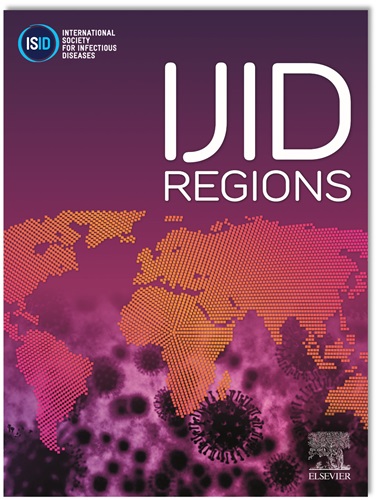Gut Inflammatory Proteins Associated with Environmental Enteric Dysfunction Can Be Measured in Wastewater
IF 4.8
2区 医学
Q1 INFECTIOUS DISEASES
引用次数: 0
Abstract
Introduction
Inhabitants of low-income countries in areas with poor sanitation suffer from high rates of Environmental Enteric Dysfunction (EED), a subclinical syndrome hallmarked by chronic inflammation of the small intestine driven by repeat and chronic enteric pathogen exposure. EED has been associated with poor linear growth and adverse neurodevelopmental outcomes in children. In adults, it has been hypothesized that EED plays a pathogenic role in obesity and metabolic syndrome. While small intestinal histology is the gold standard for EED diagnosis, protein biomarkers of enteric inflammation have been widely used as a proxy measure of EED. One of the major challenges in using such biomarkers for research is that these biomarkers are dynamic, responding to repeat pathogen exposures and clearance. This makes understanding the cumulative burden of EED and its effects on long-term outcomes difficult. Further, understanding the effect of interventions on EED burden is difficult as repeated measures in individuals may not give an accurate picture. We hypothesized that we could measure the community level of EED by quantifying levels of known fecal biomarkers of EED in wastewater.
Methods
Using commercially available ELISA kits, we attempted to measure alpha-1-antitrypsin, calprotectin, neopterin, myeloperoxidase, and neutrophil gelatinase-associated lipocalin in wastewater. The sewage samples were collected between 7 AM-9 AM from established sites in an existing sewage surveillance study in Dhaka, Bangladesh, where the EED burden is known to be high. The catchment population ranged from 2,317 to 606,332. The samples were processed at our icddr,b lab that same day. 50-100 µl of neat sewage samples were tested using ELISA kits for each EED biomarker.
Results
We detected antitrypsin (range 10.2-44.4 ng/l; mean 29.42±12.15 SD ng/l), neopterin (0-0.64 ng/µl; 0.03±0.03 ng/µl), and NGAL (0.6-1.1 ng/µl; 0.59±0.35 ng/µl) from neat samples. Calprotectin and MPO were not detected from the neat sample. We plan to concentrate the samples to detect these biomarkers in the future.
Discussion
These results demonstrate that biomarkers of EED can be measured in wastewater in a community known to have a high EED burden. The next steps involve comparing these results with those from a low EED burden catchment area (i.e. high-income country) and determining the variation in these wastewater biomarkers over time.
Conclusion
In the long term, community-level EED measures can be correlated to population health outcomes and be used to measure response to both sanitation and pathogen-targeted interventions such as vaccines.
与环境肠功能障碍相关的肠道炎症蛋白可以在废水中测量
在卫生条件差的低收入国家,环境性肠功能障碍(EED)的发病率很高,这是一种亚临床综合征,其特征是由反复和慢性肠道病原体暴露引起的小肠慢性炎症。EED与儿童线性生长不良和不良神经发育结果有关。在成人中,已经假设EED在肥胖和代谢综合征中起致病作用。虽然小肠组织学是诊断EED的金标准,但肠道炎症的蛋白质生物标志物已被广泛用作EED的替代指标。使用这些生物标志物进行研究的主要挑战之一是,这些生物标志物是动态的,对重复的病原体暴露和清除有反应。这使得了解EED的累积负担及其对长期预后的影响变得困难。此外,了解干预措施对EED负担的影响是困难的,因为对个体的重复测量可能无法给出准确的图像。我们假设我们可以通过量化废水中已知的EED粪便生物标志物的水平来测量群落的EED水平。方法采用市售ELISA试剂盒,测定废水中α -1-抗胰蛋白酶、钙保护蛋白、新蝶呤、髓过氧化物酶和中性粒细胞明胶酶相关的脂钙蛋白。污水样本是在上午7点至9点之间从孟加拉国达卡现有污水监测研究中的既定地点收集的,已知该地区的EED负担较高。流域人口由2,317人至606,332人不等。同一天,样品在我们的icddr,b实验室进行了处理。使用ELISA试剂盒检测50-100µl洁净污水样品中每种EED生物标志物。结果抗胰蛋白酶检测范围为10.2 ~ 44.4 ng/l;平均29.42±12.15 SD ng/l),新蝶呤(0 ~ 0.64 ng/µl;0.03±0.03 ng/µl), NGAL (0.6 ~ 1.1 ng/µl;0.59±0.35 ng/µl)。样品中未检出钙保护蛋白和MPO。我们计划在未来集中样本检测这些生物标志物。这些结果表明,可以在已知的高EED负担社区的废水中测量EED的生物标志物。接下来的步骤包括将这些结果与低EED负担集水区(即高收入国家)的结果进行比较,并确定这些废水生物标志物随时间的变化。从长远来看,社区层面的EED措施可以与人群健康结果相关联,并可用于衡量对卫生和病原体靶向干预措施(如疫苗)的反应。
本文章由计算机程序翻译,如有差异,请以英文原文为准。
求助全文
约1分钟内获得全文
求助全文
来源期刊
CiteScore
18.90
自引率
2.40%
发文量
1020
审稿时长
30 days
期刊介绍:
International Journal of Infectious Diseases (IJID)
Publisher: International Society for Infectious Diseases
Publication Frequency: Monthly
Type: Peer-reviewed, Open Access
Scope:
Publishes original clinical and laboratory-based research.
Reports clinical trials, reviews, and some case reports.
Focuses on epidemiology, clinical diagnosis, treatment, and control of infectious diseases.
Emphasizes diseases common in under-resourced countries.

 求助内容:
求助内容: 应助结果提醒方式:
应助结果提醒方式:


